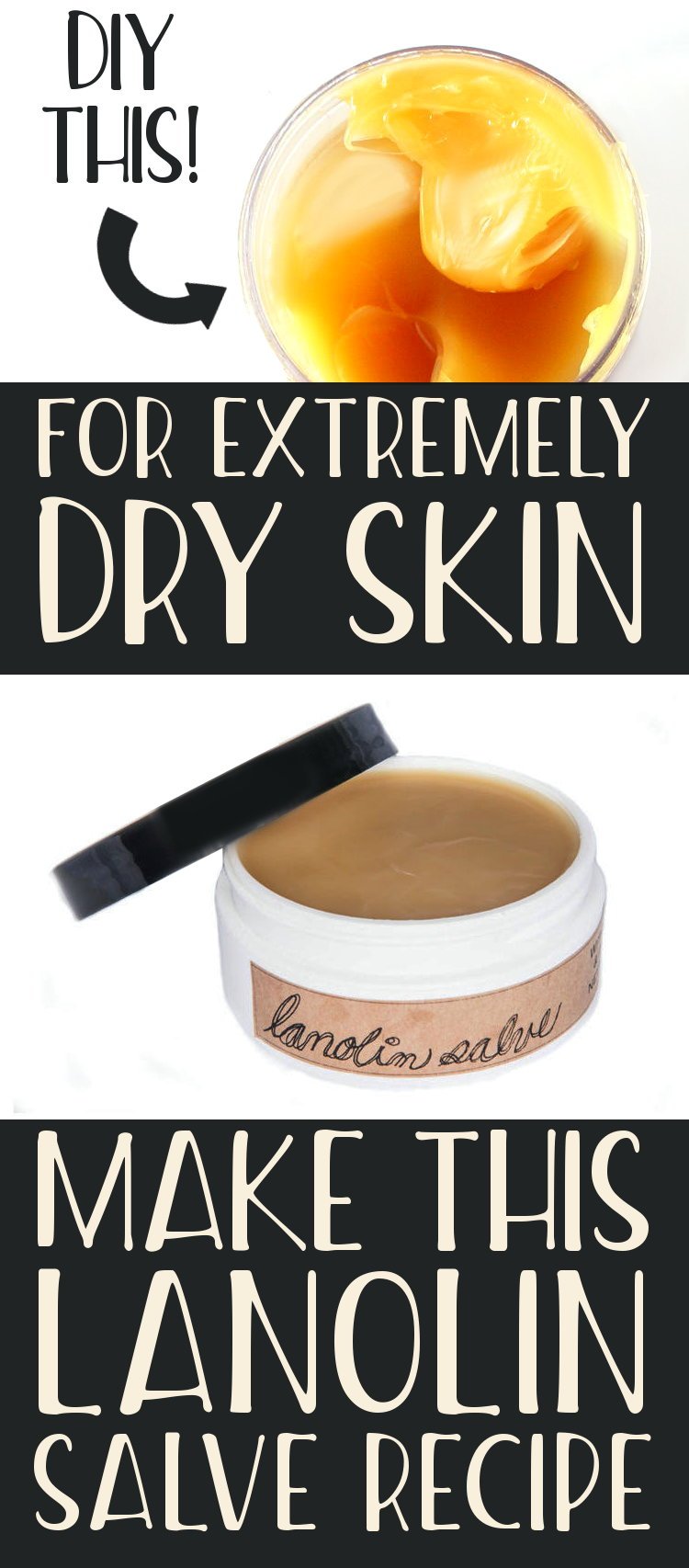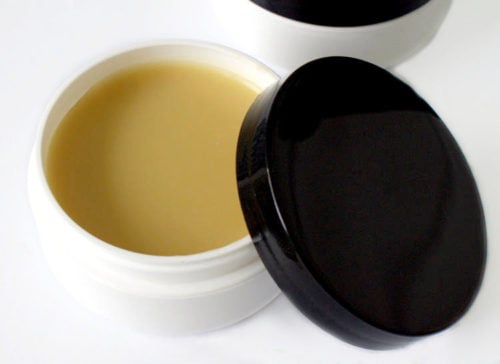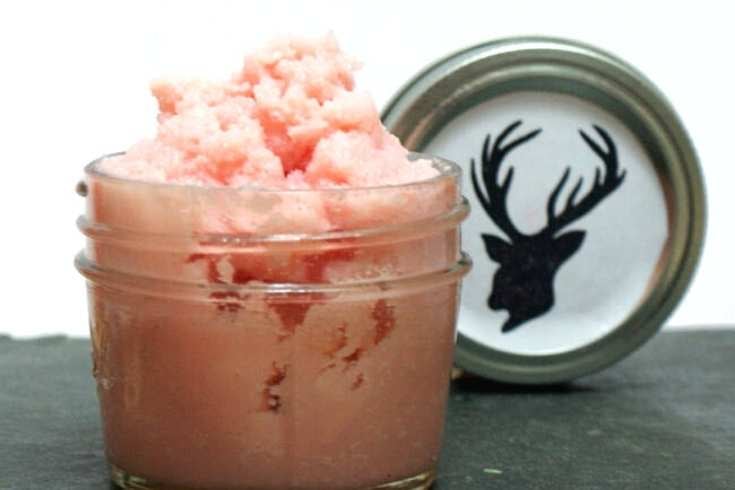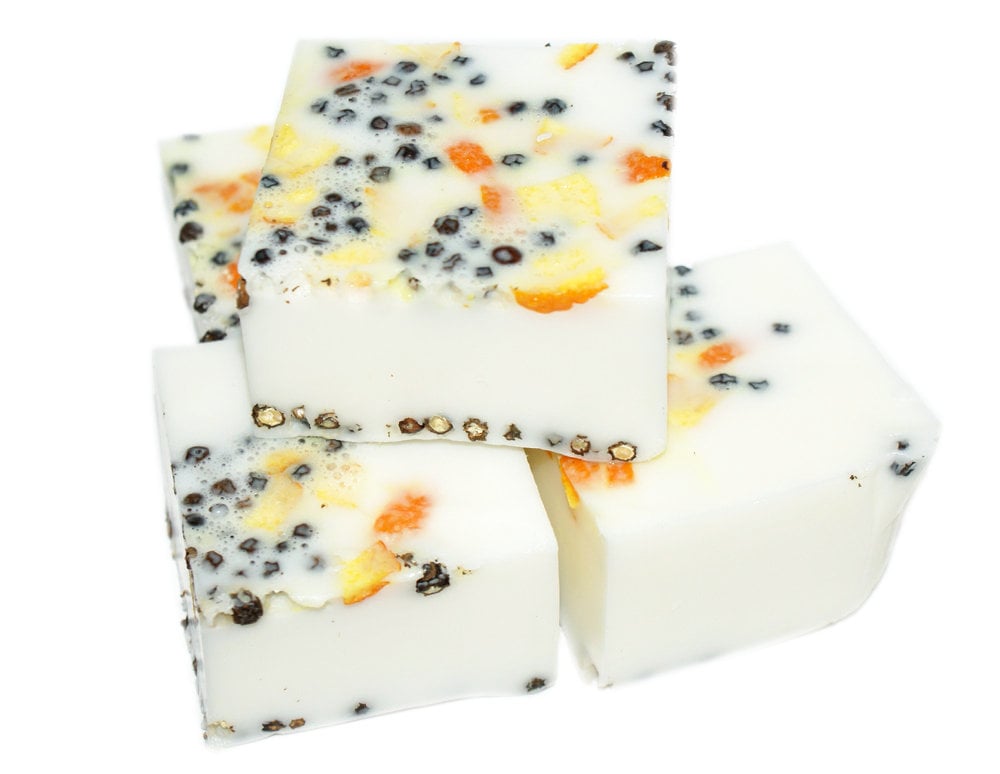
Natural Lanolin Salve Recipe for Dry, Damaged Skin
This natural lanolin salve recipe makes a wonderful alternative to commercial lotions and creams for hydrating and protecting extremely dry skin.

So, what is lanolin?
Lanolin is a naturally occurring wax that is secreted by the glands of sheep and other wool bearing animals that helps them shed water from their coats. When sheep are sheared in order to use their wool for textiles such as yarn or felt, the wool is first run through rollers in order to extract the lanolin.
Because lanolin is very similar in composition to the oils secreted by our own skin it’s able to provide a protective moisture barrier when used in skin care products. It acts as an excellent moisturizer and skin smoother as it’s capable of not only penetrating the outer layers of our own skin while still allowing it to breathe, but it is also a humectant able to attract and absorb up to 300% water.
According to Wikipedia lanolin is superior to both petroleum and glycerin with its emollient effects lasting for an eight hour period after the first application and up to 72 hours after a fifth day of consecutive use. Therefore a lanolin salve is perfect for severely dry and cracked skin, eczema and psoriasis.
In addition to the lanolin in my natural lanolin salve recipe, I’ve also used calendula and virgin cold pressed pumpkin seed oil. While calendula is proven to help promote healing, pumpkin seed oil helps to repair dry and damaged skin. Nutrients that include Omega-3 and Omega-6 fatty acids, Vitamins E, A, and C, and zinc aid in this process by promoting skin health.

Natural Lanolin Salve Recipe
Ingredients:
.5 oz. beeswax
2 oz. pharmaceutical grade lanolin
.25 oz. pumpkin seed oil
.25 oz. calendula herbal oil
15 drops lavender essential oil
5 drops tea tree oil
5 drops rosemary antioxidant
5 drops vitamin E oil
Supplies:
Digital Kitchen Scale
Two 2 oz. low profile plastic jars or tins in size of choice
Glass Pyrex Measuring Cup
Metal Utensil for Stirring
Plastic Transfer Pipettes
Microwave or Double Boiler
Instructions:
To make my natural lanolin salve recipe, you’ll begin by using a digital scale to weigh out the beeswax. Combine in a glass Pyrex measuring cup then melt in either a double boiler or in the microwave at 40% power until melted.
Carefully remove from the microwave using a pot holder. (The handle and container will be very hot.) Then weigh out the lanolin and stir into the melted beeswax. Continue stirring until the lanolin has melted completely.
Next, weigh out the calendula herbal oil and the pumpkin seed oil and stir into the lanolin and beeswax.
Using a different pipette for each oil, add the tea tree and lavender essential oils, rosemary extract and vitamin E.

Stir well then pour 1.5 oz. of salve (by weight) into each of the two 2 oz. containers. Allow to cool, then cap tightly and store in a cool, dry location.

More Natural Lanolin Recipes
If you like my natural lanolin salve recipe, then you may also be interested in trying some of my other homemade recipes with lanolin. Following are some of my favorites.
- Natural Rosemary & Neem Oil Foot Salve Recipe with Lanolin
- Homemade Salve Recipe for Eczema with Honeybush Tea
- Cracked Heel Repair Balm Recipe with Lanolin
- Natural Peppermint Lip Balm Recipe for Dry, Cracked Lips
- Palmarosa Lime Natural Body Balm Recipe for Dry, Cracked Skin
- Sea Salt Face and Body Scrub Recipe with Lanolin
- Homemade Winter Body Balm Recipe
- Homemade Chocolate Orange Body Butter Recipe
- Merlot Tinted Lip Balm Recipe with Lanolin
- Heal and Protect Winter Lip Balm Recipe
- Lavender Body Butter Recipe with Neem Oil
Don’t Miss Any of My Skin Care Recipes!
Don’t miss out on new bath, beauty and skin care from Soap Deli News! You can follow me across all of your favorite social media platforms for updates on new posts plus other great information from around the web!
Find and follow me now on Pinterest, G+, Facebook, Twitter, Blog Lovin’, and Instagram as well as subscribe to Soap Deli News via email for future updates, DIY projects and recipes.




17 Comments
Anne-Marie Faiola
August 12, 2013 at 5:15 pm
Great recipe! This will be great for moisturizing as we approach fall and winter.
Rebecca D. Dillon
August 12, 2013 at 5:59 pm
I’ve already started using this on my feet. I love how rich and nourishing it is!
Cindy
August 13, 2013 at 9:49 am
I have a liquid lanolin I just ordered. Would this work and and how would it affect it? If it would make it to runny, how could I correct it?
How hard is it to work with regular lanolin?
Thank you.
Rebecca D. Dillon
August 13, 2013 at 7:37 pm
Liquid lanolin is a different product and consistency so it won’t work for this salve recipe. You could try using the liquid lanolin and then also adding shea butter however you’d have to experiment to find the right amount. I would suggest starting with equal parts shea butter, lanolin oil and beeswax and omitting the other ingredients. Or try just the lanolin oil and beeswax and see what the consistency of that is and then blend in other ingredients. Regular lanolin isn’t difficult to work with. It has a low melt point, but when in a solid state it is a bit sticky.
Deb
August 14, 2013 at 3:03 pm
Love the idea, maybe I’ll try it someday.
Dee
December 28, 2013 at 5:35 am
Excited to try this but will have to purchase most items. What is the purpose of the pumpkin seed oil and the Botanic Extract Blend? Would the salve be ok without these? I just don’t know if they contribute to the moisturizing effects or the consistency factors. Thx for your input.
Rebecca D. Dillon
December 28, 2013 at 3:00 pm
They both contribute their natural healing properties. If you don’t want to use them you would still need to sub with another oil. Otherwise your salve will be way too hard.
Z.alami
June 6, 2014 at 12:11 pm
Hello,Mrs Dilon,
Do you have any experience using lanolin in dry nose?
Thanks.
Rebecca D. Dillon
June 7, 2014 at 11:32 am
I have not, however, it’s a slightly thicker consistency than petroleum jelly so you could use it for similar applications.
Fiona Jones
June 8, 2014 at 11:05 am
Hi I’ve just found this recipe and absolutely love it, in the past I have used rice bran oil which I understand is high in vit e. ? Do you think this has benefits over pumpkin seed oil?
Thank you so much for sharing this wonderdul recipe.
Fiona Jones
Rebecca D. Dillon
June 9, 2014 at 7:54 pm
Pumpkin seed oil is richer in nutrients. Rice bran is most similar to olive oil. You can choose which you like best based on the results you’re looking for, however, if you want a more healing oil I’d opt for the pumpkin seed oil.
Katie H.
June 20, 2014 at 12:37 pm
I made this salve for a coworker (with a few minor alterations), and she said it’s been helping her cracked feet. Thank you for sharing so many great recipes! I intend to make a lot more of this stuff. 🙂
Rebecca D. Dillon
June 20, 2014 at 4:44 pm
You’re welcome! I’m so glad your coworker found it’s helping! 🙂
stephanie
July 18, 2014 at 9:19 am
Where are you all getting the oils from? I went to the wholefood store, and they didnot know what I was talking about. So do you order these oils onliine or buy from what store, because some of this stuff you cannot just pick up at Hobby/Lobby. Thank you
Rebecca D. Dillon
July 19, 2014 at 5:26 pm
I buy pretty much everything online in bulk as it’s more cost efficient. I link to all of the ingredients I used for this project within the recipe.
Kathy
September 4, 2014 at 8:50 pm
I don’t have a digital scale. Do you by chance have the recipe in tablespoon, teaspoon measurements?
Rebecca D. Dillon
September 5, 2014 at 5:20 pm
No. Weights ensure better accuracy and allow for re-sizing the recipe easily as needed. As you need a scale to weigh the ingredients to make soap, all of my recipes will be by weight.
Comments are closed.